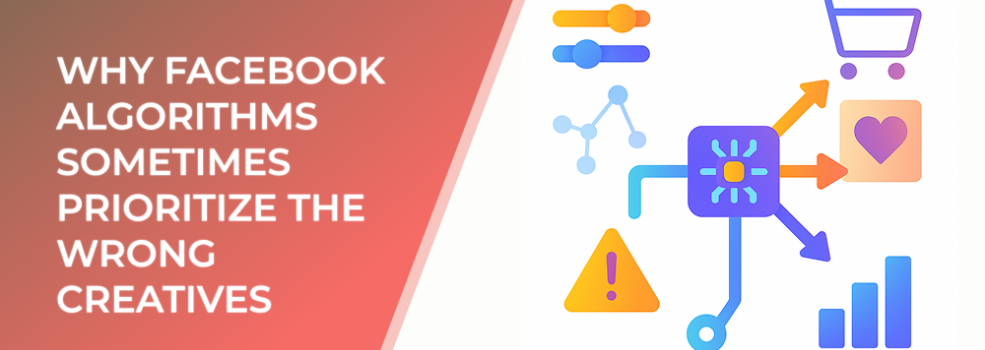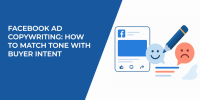Meta’s algorithm optimizes for signals it can see fastest—not necessarily the ones that predict profit—so it can aggressively back a flashy creative that drives cheap interactions while undermining conversion quality and LTV.
Useful statistics at a glance
-
Spend concentration: In mixed creative ad sets, 70–90% of spend typically consolidates into the top 1–2 ads within 24–48 hours, starving the rest of reliable data.
-
Attribution swing: Changing from 7‑day click to 1‑day click (or toggling modeled conversions) can shift reported ROAS by 15–30% on the same cohort, masking which creative actually wins.
-
Placement tilt: With automated placements, 60–80% of impressions can cluster in fast‑scroll inventory (e.g., Reels/Stories), favoring short‑hook formats over depth‑oriented creatives.
-
Learning fragility: Launching multiple new ads or making large budget edits can extend or reset learning, raising CPA/CPL by 10–35% for 48–96 hours.
These ranges summarize patterns commonly observed across performance accounts; actual impact varies by vertical, audience size, AOV, and funnel length.
Ten reasons the algorithm bets on the wrong creative
1) Early‑signal bias
The system hunts for quick wins: impressions → clicks → low‑friction events. Click‑forward creatives (curiosity hooks, sensational thumbnails) gain momentum before purchase‑quality signals are available.
Fix: Optimize to the highest reliable event (value, qualified lead, checkout start) rather than shallow proxies.
2) Mismatch between optimization event and true goal
If you optimize for link clicks or simple leads, the algorithm will find the cheapest clickers or form fillers—not necessarily buyers or qualified MQLs.
Fix: Use value‑based or qualification events (e.g., Lead_Qualified, Purchase with value). Upload offline conversions to reinforce downstream quality.
3) Attribution window whiplash
Short windows reward creatives that convert quickly and penalize those driving delayed purchases; longer windows can over‑credit upper‑funnel assets.
Fix: Lock an attribution window per funnel stage and keep it constant during tests.
4) Placement bias
Auto placements push delivery to the lowest‑cost inventory. Some creatives look “great” in Reels but underperform on intent when users need time to evaluate.
Fix: Ship placement‑aware versions; require a minimum share in Feeds for high‑consideration offers.
5) Audience‑creative mismatch
A broad audience might love an entertaining ad that pulls the wrong ICP. Sales then reports “leads went cold.”
Fix: Maintain exclusions, feed high‑purity seed signals, and run a benchmark audience (remarketing or LAL from high‑value events) to sanity‑check quality.
6) Learning‑phase noise
Large mid‑week budget jumps or mass creative uploads reset learning and distort which ad actually performs.
Fix: Batch changes, move budgets in ≤20% steps, and cap total active ads (≤6) per ad set.
7) Feedback loop penalties
High hide rates or negative comments can quietly throttle reach while clicks still look cheap, skewing comparisons.
Fix: Monitor negative feedback, refresh comment moderation, and retire creatives with persistent hides.
8) Creative fatigue disguised as “winner”
Once an ad wins spend, frequency spikes; apparent success fades in 3–10 days at scale, but the algorithm keeps feeding it.
Fix: Enforce a rotation cadence (weekly new concepts; bi‑weekly iterations) and watch frequency (>3 in 7 days is a warning for many accounts).
9) Budget fragmentation & internal competition
Too many ad sets and look‑alike ranges fight each other in auction, inflating CPMs and muddling readouts.
Fix: Consolidate structure and run a single clean test lane alongside your control.
10) Shallow diagnostics
Judging by CTR/CPC alone lets attention‑grabbing hooks win even when cart or qualification rates lag.
Fix: Track hook rate, 3‑sec views, outbound CTR and cost per qualified event; use these as kill/scale criteria.
A practical framework to keep creative selection honest
1) Structure
-
Two lanes: Control (proven assets) and Test (new concepts). Same optimization event and attribution window.
-
Limit live ads to ≤6 per ad set; test 2–3 concepts at a time.
2) Inputs
-
Define a quality event (
Lead_Qualified,Purchasewith value, orBookDemo). -
Sync offline conversions each week so Ads Manager sees pipeline value.
3) Pacing
-
Let ads run 72 hours or until 50+ conversion‑adjacent events before pruning.
-
Scale winners in 15–20% increments; avoid mid‑day edits.
4) Guardrails
-
Set stop‑loss thresholds (e.g., pause if cost per qualified event is 40% worse than control after volume).
-
Place minimums: require Feeds in high‑consideration tests; run separate Reels‑native cuts.
-
Maintain exclusions (customers, recent site buyers, irrelevant geos).
5) Measurement
-
Pre‑register success metrics: primary (CPA/ROAS), secondary (IC/ATC/Qualified), diagnostics (hook rate, thumb‑stop ratio, scroll‑stop rate).
-
Annotate any changes and keep attribution constant through the readout.
Troubleshooting checklist
-
Did the attribution window or optimization event change?
-
Is spend >70% on one ad after 24–48 hours?
-
Is frequency >3 in 7 days and CTR falling?
-
Are most impressions in one placement (e.g., Reels >70%)?
-
Are quality proxies (qualified rate, IC→Purchase) trending down while CPC looks “good”?
If you check 3+ boxes, freeze edits for 72 hours, consolidate spend, and relaunch with placement‑aware variants and a quality event.
Creative patterns that balance clicks with quality
-
Problem → Solution open with clear proof in first 3 seconds.
-
Demo‑first cuts showing outcome, not just benefits.
-
Social proof variants (ratings, UGC quotes) tailored per placement.
-
Offer clarity frames (price anchor, value stack) for buyers vs curiosity hunters.
Executive summary for stakeholders
-
Algorithms overweight fast, shallow signals; that’s why the “wrong” creative can look right in-platform.
-
Counter with better inputs (quality events, offline conversions), steady pacing, and placement‑aware assets.
-
Judge winners by downstream outcomes, not just front‑end clicks.

